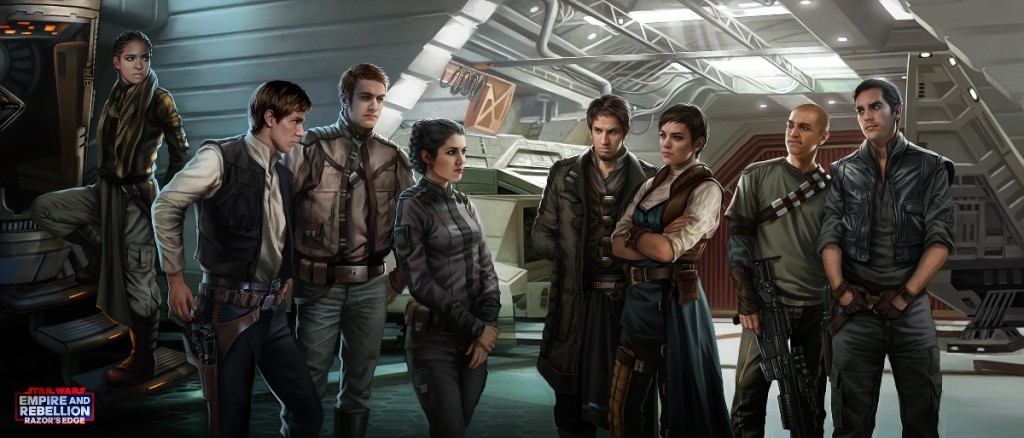
As an entire profession of costume designers would be more than happy to tell you, how you dress your characters is just as important as what you script them to say. In some ways, perhaps even more important. There’s even an Academy Award for it (which A New Hope won in 1977, among numerous other accolades – the only science fiction film ever so honored, to the best of my recollection). Movies, television, video games, and comics are all extremely visual mediums by nature: unlike a novel, you can’t just let your audience’s imagination fill in the blanks.
Every single detail, down the last button, has to be accounted for, all the more so if you’re dealing with a work of science fiction or fantasy. The more significant a role a character has, the more vital it is that you get their outfit just right. They’re your main selling point, after all: the face you’re going to plaster all over your comic covers, the costumes the stores are going to stock their shelves with come Halloween, the action figures that the children will clamor for when Christmas arrives. Get it wrong and, well, there’s a very good reason Zardoz didn’t become a franchise and comic book adaptations stopped using tights.
In the wonderful world of fiction, you truly are what you wear. Nobody simply has poor taste in clothes, not when they have an entire costume department responsible for painstakingly dressing them, and concept artists and designers behind them who were hired specifically to design clothes layered with meaning and symbolism. But this process is not always an easy one, for when you’re dealing with a setting as far removed from our own time and place as Star Wars, the wardrobe department will find themselves facing an entirely new and unusual set of challenges.
Though it freely borrows elements from science fiction and fantasy, it steadfastly insists upon keeping its feet firmly planted in both worlds, never embracing one over the other. Officially set in the distant past, but so long ago and far away as to render all forms of historical dress unusable. The veneer is, at first glance, futuristic, but close examination reveals that it has far more in common with World War II than Star Trek. There is no set standard that we can use to measure whether a costume is accurate or fits in with the rest of the universe: it’s entirely a matter of personal taste, and there’s no guarantee that the audience will see it the same way as the crew. The best you can do is to harvest from past successes while learning from the failures’ mistakes and hope for the best.

As our heroes grow and change over the course of the saga, so too do their wardrobes. When first encountered, Luke Skywalker is attired in the simple garb of the humble Tatooine moisture farmer. The soft and defenseless white fabric marks him as being as unlike Darth Vader and his sinister black armor (which we will discuss in greater detail later) as humanly possible. For the climax of the film, he graduates to the bright orange flight suit of a rebel pilot: while the color scheme may appear somewhat awkward to modern audiences, it has a real world basis in outfits once worn by American pilots. More important than the outfit itself, however, is the fact that he shares it with so many others, signaling that he has finally become a part of something greater than himself.
After escaping from Hoth and parting ways with his rebel comrades in The Empire Strikes Back, Luke trades in his standard-issue rebel uniforms for a light grey outfit that looks like something you’d expect an electrician or mechanic to wear. Circumstances would imply that it was stored in his X-wing, so perhaps that’s exactly what it was. Score a point for realism. By the time Return of the Jedi rolls around, Luke has started tap dancing along the line between the light and dark sides of the Force. We know this because he’s started dressing in black, which is never a good sign. Despite his ultimate rejection of the Emperor’s offer to take Vader’s place at his side, he wears that outfit for the duration of the film, only temporarily covering it with a camouflage poncho during his brief time on Endor.
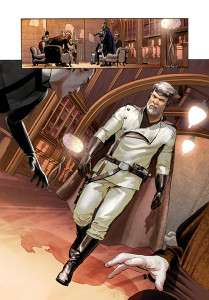
It’s difficult to say for certain where Luke’s wardrobe should go next: a lighter color scheme is not unlikely, but traditional Jedi robes and a beard run the risk of having him look too much like an Obi-Wan rehash. Ideally, you want an outfit that will convey his accumulated wisdom and status as a Jedi master while still maintaining a sense of identity that’s visibly distinct from the old order and its forgotten ways. Something not quite as long as the traditional Jedi robes, while using the tighter, more practical outline of what he wore in Return of the Jedi. Knowing Lucas’ fondness for samurai as a point of reference, we might look to the jinbaori for influence.
When it comes to Leia, white is very much her color. For all but the final scene of the first movie, she’s sheathed by the iconic white dress that gives her the sort of regal air that we expect from our space royalty. For the victory ceremony at the end of the film, she’s finally permitted to put on some fresh clothes – in the form of another white dress (this time with added necklace and a studded metal belt that cannot be comfortable). Sandwiched between the two is a missed opportunity for an Imperial prison jumpsuit Leia action figure. Having shifted from secret rebel sympathizer to active agent of the resistance, The Empire Strikes Back sees her downgrade to something more practical in the form of a winterized rebel uniform. It lasts just long enough for her to to get to Bespin, where they quickly manage to rustle up another dress for her, though at least this one isn’t completely white.
Return of the Jedi offers not just the highest number of costumes for Leia, but also the greatest variety. She starts out in disguise as an alien bounty hunter, and then finds herself wedged into the infamous metal bikini (mostly for the sake of having Carrie Fisher wedged into a metal bikini) after being captured by a corpulent gangster-slug. After strangling her captor with the very chains used to bind her, she reunites with the rebel fleet and changes into their latest uniform, which, like Luke, she complements with a camouflage poncho while deploying as part of the Endor strike team. As a guest of the native Ewoks, she finishes out the Skywalker saga in a (conveniently human-sized) plain brown dress, which I am completely at a loss to explain the origins of.

Perhaps more than any of the saga’s other main characters, the future of Leia’s wardrobe depends heavily on the role she fulfills in the sequel trilogy. Will she be the Queen of the Alderaanians? President of the galaxy? A leader in the new Jedi order, having studied the Force under her long-lost brother? All three, simultaneously? The first option would call for something that would convey majesty, while maintaining a connection to the general Alderaanian aesthetic we’ve been permitted a few glimpses of prior to the world’s destruction. Elements that bring to mind her mother’s outfits might also be called for. As the elected leader of a galaxy-spanning political entity, options for her costume branch out in many directions.
On one hand, you could refer back to the chancellors’ robes of the prequel trilogy, to establish a sense of continuity between the old and new republics. On the other, you might want to distinguish the new order from the republic that became the foundation for an empire, in which case you’d be looking for something more modern. We’ve yet to see Star Wars craft a modern business suit in its own unique style. And, of course, if she’s studying the ways of the Force, then she and Luke share wardrobe difficulties, with the added problem of potentially needing a style of clothing they can both wear while maintaining clearly separate identities.
!["I remember the memos from 20th Century Fox, 'Can you put a pair of lederhosen on the Wookie [sic]?' All they could think of was, 'This character has no pants on!' This went back and forth. They did sketches of him in culottes and baggy shorts."—Mark Hamill](http://eleven-thirtyeight.com/wp-content/uploads/2015/02/chewbacca-198x300.png)
Perhaps the single greatest fashion offender in the franchise, apart from that incorrigible nudist Chewbacca, Han Solo is rarely seen without his trademark white shirt, black vest, and bloodstriped pants, even four decades and countless adventures later. He wears it for the entirety of A New Hope, including the victory ceremony at the end (the concept of formal wear is apparently alien to him). He doesn’t even bother to take it off while disguised as a stormtrooper: it appears that he just wore it underneath the armor.
The Empire Strikes Back broadens his horizons some, switching out his pants for a similar pair with a different color scheme (yellow bloodstripes on brown instead of red on dark blue) and presenting him with a new shirt and a full jacket to replace his vest. Like Leia, he starts out in a winterized rebel uniform (though black, as opposed to her white), but happily abandons it when no longer braving the elements in search of lost Lukes. In Return of the Jedi, Han is the only protagonist who clearly regresses in his wardrobe, returning to his white shirt and vest from A New Hope after being thawed out of carbonite, though he does keep his pants from The Empire Strikes Back.
Assuming that he retains his military rank into The Force Awakens, we might expect him to leave his “scruffy-looking” smuggling days behind and don the uniform of a high-ranking officer in the restored republic (assuming, of course, that it has been restored). In such a case, the most difficult part will be coming up with a new uniform that can stand on equal footing with the iconic Imperial outfits. The Old Republic can get away with using the same general design, being the foundation upon which Palpatine’s regime was constructed, but any government born from the rebel alliance would be wise to avoid anything so evocative of their sworn enemies.

Part of what makes it so difficult to come up with new outfits for our heroes is that the Expanded Universe failed dismally at evolving their wardrobes. Post-Endor depictions of Han Solo have relied almost exclusively on his two most memorable outfits from the trilogy: usually his vest, but sometimes the jacket. His taste in clothing is static, untouched by the passage of time and independent of dress codes or trends. Nor is he alone in this: despite his ultimate rejection of the dark side, Luke was long depicted in the same black outfit he had on when confronting his father and the Emperor. Only after the release of the prequels did his wardrobe undergo any noticeable changes, and that was when it was decided that the New Jedi Order would uniformly adopt the robes of their predecessors. Leia, when actually permitted to make an appearance, fared little better.
Of course, there are perfectly logical out-of-universe reasons for this. It is desirable that your heroes be easily recognizable (and marketable), especially if you fear that your audience might be too dim to identify them if they change their outfits as frequently as normal human beings do. Furthermore, most cover and comic artists have accurately portraying the characters as their first priority, and are not concept artists or professional costume designers. It’s likely far simpler for them to fall back on pre-existing depictions of a character than to invent something entirely new and re-learn how to draw them.
So what can be done to rectify this regrettable situation? We can hope that authors spice up descriptions of their characters with detailed notes on their clothing, and that the content of a book influences what appears on its cover. Not holding my breath on that one, though. More realistically, we might hope that the sequel trilogy (and its assorted spinoffs) will gift its cast with as broad an array of costumes and outfits as Padmé had in the prequels, so that future depictions of these characters will be less likely to latch onto one template with the single-minded death grip of a small child clinging to its favorite toy.
But that’s enough of that. These characters may wear their clothes like uniforms, but they also have actual uniforms that circumstances do occasionally call for them to wear. As is a surprisingly frequent phenomenon when it comes to villains, the servants of the Galactic Empire possess some of the most iconic costumes in the franchise, and certainly the most famous uniforms of any of the prominent factions. In line with how much of the Original Trilogy is reminiscent of World War II, the well-polished boots and tightly fitted grey and black uniforms worn by Imperial officers are obviously designed to bring to mind goose-stepping Nazis. That they succeed at doing so while still looking passably futuristic so many years later is a testament to the efficiency of their spartan design scheme.
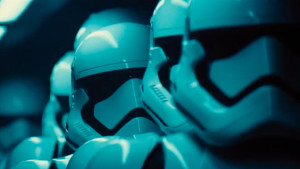
Imperial stormtrooper armor looks a bit clumsier if you examine it closely, but what they lack in fine details they make up for with their iconic faceless helmets, which render them more symbols of Imperial authority than men. The simplicity of their design also allows for it to be easily altered as needed: see the snowtroopers deployed on Hoth or the scout troopers found on Endor (though their lack of camouflage really is an unforgivable strategic error), along with a impressive number of other variations found throughout the Expanded Universe. I’d comment on how that should also make it a fairly simple matter to update the design for the sequel trilogy, but we’ve already had our first look at their successors in The Force Awakens, though it wasn’t exactly a clear one.
Of course, no discussion of Imperial outfitting would be complete without mention of Darth Vader. An unholy hybrid of a medieval black knight and a Japanese samurai, there is no character in the franchise with a more instantly recognizable outline. In him, the two seemingly opposed influences of the saga are embodied in a single form – fantasy and science fiction, man and machine, knight and cyborg, distant past and far-flung future. Darth Vader is the sinister and intimidating representative of the Emperor’s dark will, yes, but as a timeless and classic fictional icon he’s also a visual guidepost for everything that Star Wars aspires to be.
Though better known and (quite rightly) far more popular as the Emperor’s personal Terminator, Luke’s father wasn’t born wearing that armor. Once upon a time, he too wore the humble attire of a Tatooine desert denizen. But when it comes to the prequel trilogy, it’s what he wears once he joins the Jedi that is of the greatest interest to us. It’s easy to forget that before young Obi-Wan Kenobi and Qui-Gon Jinn came along, we really had no idea how a Jedi Knight was supposed to dress. Given the title, it should come as no surprise to learn that they even considered having them wear armor during the concept stage.
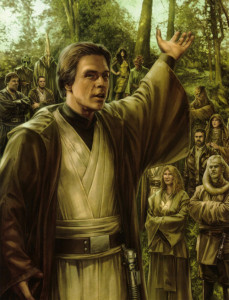
While we were in the dark, members of Luke’s order mostly wore the same clothes they did long before they ever picked up a lightsaber. While having Anakin deviate from the norm established for the rest of the order did help emphasize his alienation from them, the uniform nature of their robes does contribute toward making the rest of the Jedi seem forgettable and interchangeable by comparison. If Luke’s new Jedi are to become the foundation for as many stories as Vader’s bounty hunters or the Jedi Council members in The Phantom Menace, then I think they would benefit greatly from more personalized outfits.
While the most memorable costumes obviously belong to the main cast, that’s not to say that the extras are entirely unworthy of note. While the camera rarely focuses on any one of them for long, collectively they play a hugely important role in establishing the tone of whatever location they happen to inhabit. Jabba’s Palace and the Mos Eisley Cantina are both exquisite catalogues of desert-dwelling scum and villainy, their motley nature reinforcing Luke’s commentary on Tatooine’s remoteness from the civilized galaxy, and the colorful and varied appearances of their denizens proved sufficiently popular for them to receive their own short story collections in the form of Tales from Jabba’s Palace and Tales from the Mos Eisley Cantina.
Despite the brevity of their screen time, the aforementioned bounty hunters that Vader summoned to the deck of the Executor in The Empire Strikes Back enjoyed a similar degree of popularity disproportionate to the significance of their roles, and were further explored in Tales of the Bounty Hunters. Though they (unfortunately) failed to receive their own novel, the inclusion of numerous alien officers in the rebel fleet in Return of the Jedi (particularly their leader, Admiral Ackbar) added a new dimension to the Galactic Civil War, framing the rebellion as a diverse and tolerant entity in opposition to the purely humanocentric Empire. A similar phenomenon can be observed with the Jedi Council in the prequels, where humans are refreshingly in the minority.
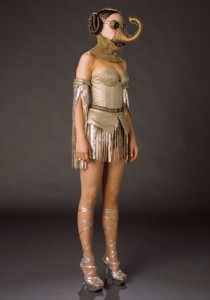
Of course, given the size of the sets and the number of extras milling around, it’s inevitable that some fashion disasters will slip through. Take, for example, the numerous patrons of the Outlander Club in Attack of the Clothes or the Galaxies Opera House in Revenge of the Sith. At a distance, they both provide a cosmopolitan array of assorted guests and notables. When you actually take the time to look closely at them, however, the illusion shatters and more than a few serve as prime examples of what not to do if you want an outfit to look timelessly futuristic. Or even if you just don’t want your audience to burst out into uncontrollable laughter (Delva Racine, I’m looking at you).
A New Hope was released in 1977. The Force Awakens is currently set to be released at the end of 2015. In reality, we no longer dress anything like we did in the seventies. Times change, and our clothes with them. Entire subcultures rise and fall and are resurrected and reimagined. Star Wars’ general aesthetic has aged remarkably well compared to many of its contemporaries, but there’s always room for improvement. The saga has often been praised for its worn and battered designs, which appear to be making something of a comeback in the next film, but there’s no real reason we should expect the entire galaxy to look that way.
The original trilogy was specifically set on the fringe, far beyond the beating heart of galactic civilization. Just compare and contrast Tatooine with Cloud City, a place as straightforwardly futuristic as anything you’d find in a work of science fiction made today. And it would be terribly humanocentric of us to assume that different alien species would not have their own unique and distinct styles of fashion. Though there was some criticism that elements in the prequels looked too futuristic and modern to predate the original trilogy, that is no longer a concern. The sequels are entering uncharted territory: everything that we’ve seen so far has been leading up to this point, and any new designs or concepts seen in The Force Awakens must be examined as an evolution of what came before.
There are many things that I hope to see in the sequels. Most important, an effort made to emphasize the passage of time since the Battle of Endor. New, less monastic outfits for the Jedi that encourage their individuality and display a clear departure from the stifling old ways. Military uniforms and body armor that aren’t based on anything used by the Galactic Empire, or the rebellion, for that matter (a new republic ought to cultivate an image of respectability and legitimacy).
A wardrobe full of context-appropriate outfits for each of our heroes as large as the one Padmé had. Extras who inspire the same sort of curiosity that first led us to become obsessed with knowing the names and stories of every single face in a film. The aesthetic of the original trilogy undoubtedly played a massive part in its enduring success, but I have no desire to see it become the standard for the entire franchise. The galaxy is much, much larger than just Tatooine, Hoth, Bespin, and Endor, and I look forward to seeing if the sequels are able to forge a unique visual identity of their own that distinguishes them from the rest of the saga.

LATE TO THE PARTY (blame a con) but I had to comment on this and say how much I love that you wrote this. The amount of work and detail put into the costumes of this saga has been absolutely incredible and tells you so much about who the characters are. I’m looking forward to the costume art books for the new films SO MUCH and not just because I’m clinging to the hope that we’ll see the costume department do what the EU cover artists rarely did and show us Leia/Luke/Han in different outfits as they get older and not just some OT rehash.
ALSO. I love everything in the header image you used. Minus t-shirt dude. But all of those other outfits? A+.
I’ll shut up now, I’m sorry. I just have a lot of feelings about costumes.
By all means, please continue. Costume design is a fascinating subject (one of my favorites, in fact), especially when you’re working with uncharted territory like the Original Trilogy was. One of the things I’d like to have discussed more is the ability of comics and games to take unused concept art and make a reality out of it: we’ve seen it done more than few times, but there are still so many incredible designs still left on the drawing board, to say nothing of the ones that we never even get to see.
I’m almost looking forward to the artbooks for the Sequel Trilogy more than the movies themselves. Just imagine how many variations of the updated stormtrooper design there’ll be. You can never have too many Imperial [something]troopers. The officer uniforms are what I really can’t wait to see, though, for both sides.
I’m particularly fond of the way the costumes in the header image manage to look distinctly more modern and Earthlike than almost anything saw onscreen in the saga, and yet somehow still don’t look even a bit out of place. Somebody is very talented.
That’s actually one of the things that I adored about The Star Wars– all those glorious costume designs that felt similar yet so different. Concept art is so great. This makes me think of how they took an unused piece of Padme concept art and use it for Sheltay I wish we could see more of the unused stuff. You should write a follow up piece on that. 😉
The 501st will have a field day with all those new troopers. The officers uniforms are going to be fantastic. They have to be. I mean, just look at the Imperial uniforms! (Says the girl who’s firmly in the Rebel camp and yet just preordered herself the ANOVOS uniform..) I’m really hoping we get something just as good for the New Republic uniforms.
That Leia jacket’s been on my to-make list for ages because it just so fantastic.
Are you going to Celebration? If so, we need to sit down and nerd out about costume design at some point.
Hey, you get enough twenty-somethings in a room and there’s bound to be one in a t-shirt.
I feel like I should take offense at that on behalf of my fellow 20 somethings but I can’t :p
Alas, I’ve never been to a Celebration, not does that appear likely to change in the near future. At least, not unless they decide to do one in Canada, but we’re probably too environmentally similar to Hoth for that be appealing to anyone. Costume design nerding will have to remain limited to the great internet for the moment.
Also, comment section trees need longer branches. Tech department, get on that.
I forwarded your request to the Tech Department, but I don’t think he was listening.